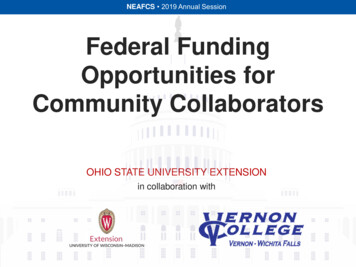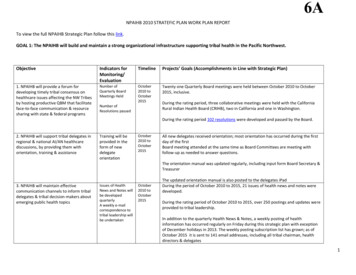
Transcription
NEAFCS 2019 Annual SessionFederal FundingOpportunities forCommunity CollaboratorsOHIO STATE UNIVERSITY EXTENSIONin collaboration with
OHIO STATE UNIVERSITY EXTENSIONPresented by:Melissa J. RuppJerry Braatz, AICPExtension Educator,Family and Consumer SciencesFulton CountyOhio State University ExtensionFFTF Vice Chair2016-2018Area Director, Area 20Extension Waukesha CountyUniversity of WisconsinFFTF Team Captain2018-2019In partnership with:Michelle A. AlexanderChair, CASE Federal Funding Task ForceDirector of Institutional AdvancementExecutive Director,Vernon College FoundationVernon College,Vernon, TexasFAMILY AND CONSUMER SCIENCESHealthy People Healthy Relationships Healthy Finances
OHIO STATE UNIVERSITY EXTENSIONThe ChangingFinancial LandscapeFAMILY AND CONSUMER SCIENCESHealthy People Healthy Relationships Healthy Finances
OHIO STATE UNIVERSITY EXTENSIONA New Mindset is Needed"Four years ago, grants and contractsexceeded our Michigan state budgetallocation for the first time. Grants,contracts, and educational serviceagreements is where the growth is."Jeffrey Dwyer,Director of Michigan State UniversityCooperative Extension(May, 2018)FAMILY AND CONSUMER SCIENCESHealthy People Healthy Relationships Healthy Finances
OHIO STATE UNIVERSITY EXTENSIONA New MindsetProgram NeedProgram FundingFAMILY AND CONSUMER SCIENCESHealthy People Healthy Relationships Healthy Finances
OHIO STATE UNIVERSITY EXTENSIONCreating a DiversifiedRevenue PortfolioState USDA SmithLeverLocalFunding/LevyLand ntsFAMILY AND CONSUMER SCIENCESHealthy People Healthy Relationships Healthy Finances
OHIO STATE UNIVERSITY EXTENSIONGrants in Practice at UWMadison ExtensionPublic and Private PartnershipsFAMILY AND CONSUMER SCIENCESHealthy People Healthy Relationships Healthy Finances
OHIO STATE UNIVERSITY EXTENSIONWhat is FFTF?The Federal Funding Task Force 70-75 Volunteers from across the Country 40 Federal Agencies & Departments 3 Days in Washington, DC 1 Annual ReportFAMILY AND CONSUMER SCIENCESHealthy People Healthy Relationships Healthy Finances
OHIO STATE UNIVERSITY EXTENSIONWHY FFTF?The annualFederal Funding Report forEducationis the premier resource on federal fundingopportunities and is made availableexclusively to members of the Council forAdvancement and Support of Education(CASE).FAMILY AND CONSUMER SCIENCESHealthy People Healthy Relationships Healthy Finances
OHIO STATE UNIVERSITY EXTENSIONFederal Funding Report forEducationFAMILY AND CONSUMER SCIENCESHealthy People Healthy Relationships Healthy Finances
OHIO STATE UNIVERSITY EXTENSIONFAMILY AND CONSUMER SCIENCESHealthy People Healthy Relationships Healthy Finances
OHIO STATE UNIVERSITY EXTENSIONAccessing the ReportCASE-FFTF.EDITME.COMMarc WestenburgDirector, Center for Community College AdvancementCouncil for Advancement and Support of Education1307 New York Ave, NW, Suite 1000Washington, DC 20005-4701 1 (202) 478-5570mwestenburg@case.orgFAMILY AND CONSUMER SCIENCESHealthy People Healthy Relationships Healthy Finances
OHIO STATE UNIVERSITY EXTENSIONAgencies found in Report National Science FoundationUSDA: NIFAUSDA: RuralDevelopmentHRSA: Rural HealthPolicyED: StrengtheningInstitutions (Title III)ED: HBCUHRSA: Div of NursingHRSA: Div of HealthCareersHRSA: Div ofMedical/Dental-BhWET Dept of Transportation What Works Commerce: EDA ED: International ClearinghouseState DepartmentNEACorp. for National &Community ServiceNuclear RegulatoryCommissionED: Office of ParentalOptionsED: AcademicImprovementEd/Foreign Language ED: OCTAE NIHED: TRIO DOL: ETADOJ: Violence Against WomenDOJ: COPS Institute ofMuseum/Library Sciences ANDNEHED: Title VCommerce: NOAAMOREFAMILY AND CONSUMER SCIENCESHealthy People Healthy Relationships Healthy Finances
OHIO STATE UNIVERSITY EXTENSIONAgency Spot lights USDA: National Institute forFood and Agriculture HRSA: Federal Office of RuralHealth Policy HHS: Substance Abuse andMental Health Service Admin.FAMILY AND CONSUMER SCIENCESHealthy People Healthy Relationships Healthy Finances
USDA: NATIONAL INSTITUTE OFFOOD AND AGRICULTUREDr. Victoria S. LeBeauxUSDA: NIFA
Agency Update: Strategic Direction/changes1. No Farm Bill – will determine strategic direction over next 5 years1.UPDATE: Farm Bill signed December 20, 2018.2. USDA might move out of DC as early as summer 2019. (Update:moving to Kansas City)3. Pay attention to AFRI – Education and Workforce Development Highest Award Rates – PD-Step 35%; REEU – 21%4. 2019 – more funding for training or retraining agricultural workers– low to middle or middle to high skill5. Federal Community College Working Group includes USDA NIFA –Dr. Victoria LeBeaux; Dept. of Ed OCTAE– Erin Berg; HHS and NASA1.2.3.Meet quarterlySubmit your ideas to Dr. LeBeaux for the group to discuss.Have the group present at a future conference?USDA: NIFA
Programs with Funding:1. Program name/CFDA: Tribal Colleges Research Grants Program (TCRGP)CFDA: 10.227Program purpose: To assist 1994 Land Grant Institutions (Tribal Colleges)in building institutional research capacity through applied projects thataddress student educational needs and solve community, reservationor regional problems.Funding levels: 12 awards in 2018; 1,700,000; 60,000 - 220,000; 80%award rateAnticipated Release: Spring 20192. Program name: Tribal Colleges Education Equity Grants Program (TCEG)CFDA: 10.221Program purpose: To enhance educational opportunities for NativeAmericans in the food and agricultural sciences.Funding levels: 34 awards in 2018; 3,400,000Anticipated Release: Spring 2019USDA: NIFA
Programs with Funding:3. Program name: Alaska Native-Serving and Native Hawaiian-ServingInstitutions Education Competitive Grants Program (ANNH)CFDA: 10.228Program purpose: To promote and strengthen the ability of Alaska NativeServing Institutions and Native Hawaiian-Serving Institutions to carry outeducation, applied research, and related community development programs.Funding levels: 3 awards in 2018; 3,000,000; 150,000 - 1,450,000Anticipated Release: Spring 20194. Program name: Beginning Farmer and Rancher Development Program (BFRDP)CFDA: 10.311Program purpose: Education, mentoring, and technical assistance initiativesfor beginning farmers or ranchers.Funding levels: 36 awards; 18,508,622-FY18; 300,000- 600,000 (up to 3yrs.)USDA: NIFAAnticipated Release: Late November 2018
Programs with Funding:5. Program name: Secondary Education, Two-Year Postsecondary Education,and Agriculture in the K-12 Classroom Challenge Grants (SPECA)CFDA: 10.226Program purpose: Promotes secondary and two-year postsecondaryeducation in food, agriculture, natural resources and human sciences andlinkages between K-14 and higher education programs.Funding levels: 6 awards, 858,600 for FY18; est. 50,000- 250,000 (2-3 yrs.)Anticipated Release: February 20196. Program name: Women and Minorities in Science, Technology, Engineering,and Mathematics Fields Grant Program (WAMS)CFDA: 10.318Program purpose: To support research, education/teaching, and extensionprojects that increase participation by women and underrepresentedminorities from rural areas in STEM.Funding levels: 4 awards in 2018 (60-80 applicants); 400,000 totalAnticipated Release: January / February 2019USDA: NIFADon’t submit unless you think you are an innovative and compellingapplicant.
Programs with Funding:7. Program name: Community Food Projects (CFP) Competitive Grants ProgramCFDA: 10.225Program purpose: Meet the food needs of low-income individuals; Increasethe self-reliance of communities; Promote comprehensive responses tolocal food access, farm, and nutrition issues; and Meet specific state, localor neighborhood food and agricultural needs.Funding levels: 33 awarded in 2018; (1) 400,000 over up to 4 years - nomore than 125,000 per year of project and (2) up to 35,000 (over 8,000,000 total funding, award rate is approx. 18%)Anticipated Release: Last year's was in September; no next release date yet;sign up for release update at grants.gov using CFDA above8. Program name: AFRI Education and Workforce DevelopmentCFDA: 10.310Program purpose: Develop future professionals in the food and agriculturalsciences, through professional development for K-14 teachers andeducators, training undergraduate students, and pre-/post-doctoralfellowships.Funding levels: New program / 24.1 millionUSDA: NIFAAnticipated Release: Spring 2019
5 Key tips from Funder1. Dr. Victoria LeBeaux is the “Community College” person atUSDA.2. Her supervisor, Dr. Sureshwaran mentioned that if CASEhosted a listening session for NIFA, they would send staff.3. Review NIFA Webinars online – very well-done andinformative.4. USDA developed a list of agriculture-related programs atcommunity colleges.5. Strong proposals: Innovative, some data gathered, meet aUSDA: NIFAneed (ex. Workforce shortage)
HRSA: Federal Office of Rural Health PolicyContact: Meriam MikreHRSA FORHP
Agency Update: Strategic Direction/Changes1.Strategic direction is guided by rural health needs andadministrative priorities – currently, substance abuse and mentalhealth2.In alignment with HRSA’s mission, FORHP grant programs aredesigned to increase access to health care for underservedpopulations and build health care capacity at state and local levels3.It was highly recommended that community colleges see HRSA’sBureau of Health Workforce (not a FORHP program) for more grantopportunities that serve rural communities that need healthworkforce developmentHRSA FORHP
Programs with Funding:1.Program name: Rural Health Care Services Outreach programCFDA: 93.912Program purpose: Promote rural health care services by enhancinghealth care delivery in rural communities.Funding levels: Up to 25 awards/ 5 million totalAnticipated Release: Annually/October2.Program name: Telehealth Network Grant ProgramCFDA: 93.211Program purpose: Demonstrate how telehealth networks are used toa) expand access to, coordinate, and improve quality of health careservices;b) improve/expand the training of health care providers; and/orc) improve/expand the quality of health information available to healthcare providers, patients and families for better decision-makingFunding levels: Up to 20 awards/ 6 million totalHRSA FORHPAnticipated Release: February, 2020 (4-year funding cycle)
5 Key Tips from Funder1. Connect with your state or regional Offices of Rural Health formore information about how your organization can collaboratewith others on current and upcoming projects and priorities.2. Partnerships/Consortia are required. Use online grantee directoryfor project summaries and contact information for currentprojects.3. Lead applicants must be located in a HRSA designated rural area,not just rural populations. Use the ‘Am I Rural’ tool to determineeligibility.4. Sign up for updates from the Office of Rural Health Policy5. Sign up as a reviewer through the website. After you register, youcan also email the program officer with your resume/information.HRSA FORHP
Health and Human Services:Substance Abuse and Mental HealthServices AdministrationAnne Herron, Director of the Divisionof Regional and National Policy LiaisonSAMHSA
Agency Update: Strategic Direction/changes1.SAMHSA’s application procedures have changed. Allapplicants must register with NIH’s eRA Commons in orderto submit an application. Consult Helpdesk regardingsystem warnings and errors. Errors require fix andresubmission.2.A new manual is available for applicants entitled“Developing a Competitive SAMHSA GrantApplication.” Webinar to review the new document washeld on November 26, 2018 (see recording)SAMHSA
Programs with Funding:1. Program name: Campus Suicide Prevention Act (Garrett Lee SmithMemorial Act)CFDA: 93.243Program purpose: Assists IHEs to prevent suicide and enhance servicesfor students with at-risk mental and behavioral health problems.Funding levels: Up to 18 Awards at 100k per year for 3 yearsAnticipated Release: Typically released in December, due in February2.Program name: Drug Free Communities Support ProgramCFDA: 93.276Program purpose: Establish and strengthen collaboration amongcommunities, public and private non-profit agencies, and governmentsto support the efforts of community coalitions working to prevent andreduce substance abuse among youth and adults.Funding levels: 120 awards at up to 125,000 per year (up to 5 years)Anticipated Release: Released January, Due in MarchSAMHSA
Tips!1. SAMHSA recommends that you submit your application at least24-48 hours prior to the deadline. The system may crash withtoo many last minute electronic submissions.2. Provide explicit detail for all of your responses to the evaluationcriteria. Do not simply re-state or “parrot” the information inthe FOA.3. Coalitions and partnerships are key!TIPS FROM FFTF MEMBERS Building in a year of planning may be helpful for the CampusSuicide Prevention grants. Campus Suicide Prevention Grants are only awarded once, soprevious winners may be more willing to share funded proposals.SAMHSA
OHIO STATE UNIVERSITY EXTENSIONFirst Hand Experience:Join the task force !Reasons to join: First hand knowledge of new and changing programs Personal connection to federal program officers Networking with other grant professionals across the nation Gain perspective for relevant emerging grant task-forceFAMILY AND CONSUMER SCIENCESHealthy People Healthy Relationships Healthy Finances
OHIO STATE UNIVERSITY EXTENSIONFeedback from you FAMILY AND CONSUMER SCIENCESHealthy People Healthy Relationships Healthy Finances
OHIO STATE UNIVERSITY EXTENSIONThank you forparticipating! Jerry Jerold.braatz@wisc.edu 262-548-7786 (direct) Melissa Rupp.26@osu.edu 419-337-9210FAMILY AND CONSUMER SCIENCESHealthy People Healthy Relationships Healthy Finances
USDA: NIFA 1. Program name/CFDA: Tribal Colleges Research Grants Program (TCRGP) CFDA: 10.227 Program purpose: To assist 1994 Land Grant Institutions (Tribal Colleges) in building institutional research capacity through applied projects that address student educational needs and solve community, reservation or regional problems.











